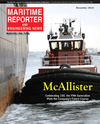
Page 16: of Maritime Reporter Magazine (November 2014)
Workboat Edition
Read this page in Pdf, Flash or Html5 edition of November 2014 Maritime Reporter Magazine
16 Maritime Reporter & Engineering News • NOVEMBER 2014
What is reported to be the world’s ? rst
LNG hybrid barge of Becker Marine
Systems was christened Hummel on
October 18, 2014, at Grasbrook Quay in HafenCity Hamburg. The godmother of the inaugural event for the ? oating
LNG power plant for environmentally friendly energy supply of cruise ships was Dr. Monika Griefahn, Chief Sus- tainability Of? cer at AIDA Cruises.
By using of the ? oating LNG power plant, emissions and particle discharge will be reduced. Compared to the use of conventional marine diesel with 0.1 percent sulfur content, no sulfur oxides and no soot particles are emitted. Ni- trogen oxide emissions will be reduced by up to 80 percent and carbon dioxide emissions by 30 percent.
With the start of the new cruise sea- son in the spring of 2015, it is planned to supply the AIDAsol for the ? rst time with electricity produced from lique? ed natural gas (LNG) while it is berthed in the port of Hamburg.
All ships of the AIDA ? eet which were put into service in 2007 or later are already prepared for the use of shore power.
Since 2007 the company has volun- tarily used only marine diesel with 0.1 percent sulfur content for the produc- tion of energy on board its ? eet in the
Port of Hamburg. This has been re- quired by law for all seagoing vessels in European ports only since 2010.
Two summers ago the company ad- opted an additional investment program in the amount of more than $100m for the use of environmental technologies, the core of which is a comprehensive ? lter system for reducing exhaust gas emissions. The ? ltration system will be featured on newbuilds, and also will be retro? t on existing ships.
In the spring of 2016, the ? rst ship of the new AIDA generation, AIDAprima, will be moored for the ? rst time in its future home port of Hamburg. AID-
Aprima is the ? rst cruise ship with a shore power connection, a comprehen- sive system for exhaust gas aftertreat- ment, and a dual fuel engine.
Glycerine
Is it the next Marine Fuel?
Following a year described as “intense activity,” the Glycerine Fuel for Marine
Sustainability project (GLEAMS) conclud- ed that Glycerine is a viable, exception- ally clean alternative marine fuel.
The GLEAMS project claims that it has been particularly successful in dispelling the notion that glycerine is unsuitable for use as a fuel due to its physical and chemical properties, as it demonstrated that glycerine could be used as a fuel in compression ignition engines by dis- playing the glycerine powered GLEAMS emissions test engine at Seawork Inter- national 2014. While the use of glycerine has been studied and documented, the
GLEAMS team realizes the importance of real-world operation, and the partners committed to an outline plan for its com- mercial realization, which includes pilot operational usage. The project partners are currently exploring early potential adopters for the technology including wind farm support vessels, research and education vessels, military special- ist craft and superyachts. In addition a potential market for ‘cold-ironing’ (shore power) has been recommended by the project as a special case where subsi- dies could be available in the UK.
Glycerine is currently produced as a by-product of the bio-diesel industry and is in surplus supply. However, the avail- able quantities are insuffi cient to power the world’s deep-sea shipping fl eets but could support a range of smaller vessel types and shore applications. There is potential for a massive increase in glyc- erine supply from other organic renew- able means such as salt-stressed algae. http://groupspaces.com/
GLEAMSInterestGroup/join/
MARINE FUEL
AIDA Cruises
World’s First LNG Hybrid Barge
TECH NOTES
In 2015 it is planned to supply the AIDAsol with electricity produced from lique- fi ed natural gas (LNG) while it is berthed in the port of Hamburg and fueled by
Hummel, an LNG hybrid barge.
Wilhelmsen Technical Solutions (WTS) completed the gas trial for the ? rst LNG carrier built to a Boil Off
Rate (BOR) of 0.08% per day.
WTS subsidiary company Ti Group completed the test on the LNG carrier
Seishu Maru, currently under construc- tion at MHI in Japan for NYK Line.
Ti Group was responsible for supply- ing the cargo tank insulation system on
Seishu Maru, one of six LNG carriers to be delivered in this order. The ves- sel is a next generation Sayaendo de- sign vessel, with a cargo capacity of 150,000 cu. m. The ship passed its gas trial and was delivered to the owner in late September 2014. “Passing the test at a BOR of just 0.08% is a milestone for the project and sets a standard that re? ects our knowl- edge and expertise in this area,” said
Anstein Sorensen, Ti Group Managing
Director. Ti Group provides two options for cargo tank insulation based on dif- ferent technologies. The panel system is an adaptable solution for LNG/LEG/
LPG cargo tanks, with a design that can be ? tted to most tank geometries. The company also offers an insulation sys- tem for LPG carriers, based on spray foam technology.
WTS LNG Cargo Containment Systems
Ti Group provided the insulation systems for six Sayaendo-design 150,000 cubic meter capacity LNG carriers under construction at
Mitsubishi Heavy Indus- tries in Japan for NYK/
MOL and K-Line.
MR #11 (10-17).indd 16 11/4/2014 10:02:32 AM

 15
15

 17
17
